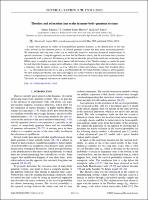Please use this identifier to cite or link to this item:
https://hdl.handle.net/20.500.12202/6449Full metadata record
| DC Field | Value | Language |
|---|---|---|
| dc.contributor.author | Santos, Lea F. | - |
| dc.contributor.author | Schiulaz, Mauro | - |
| dc.contributor.author | Torres-Herrera, E. Jonathan | - |
| dc.date.accessioned | 2020-11-19T20:13:08Z | - |
| dc.date.available | 2020-11-19T20:13:08Z | - |
| dc.date.issued | 2019-05-28 | - |
| dc.identifier.citation | Santos, Lea F., Mauro Schiulaz, E Jonathan Torres-Herrera. (2019). Thouless and relaxation time scales in many-body quantum systems. Physical Review B 99(17): 174313. | en_US |
| dc.identifier.issn | Print: 1098-0121 Electronic: 1550-235X | - |
| dc.identifier.uri | https://doi.org/10.1103/PhysRevB.99.174313 | en_US |
| dc.identifier.uri | https://hdl.handle.net/20.500.12202/6449 | - |
| dc.description | Research article, peer-reviewed. Open Access. | en_US |
| dc.description.abstract | Abstract A major open question in studies of nonequilibrium quantum dynamics is the identification of the time scales involved in the relaxation process of isolated quantum systems that have many interacting particles. We demonstrate that long time scales can be analytically found by analyzing dynamical manifestations of spectral correlations. Using this approach, we show that the Thouless time tTh and the relaxation time tR increase exponentially with system size. We define tTh as the time at which the spread of the initial state in the many-body Hilbert space is complete and verify that it agrees with the inverse of the Thouless energy. tTh marks the point beyond which the dynamics acquire universal features, while relaxation happens later when the evolution reaches a stationary state. In chaotic systems, tTh≪tR, while for systems approaching a many-body localized phase, tTh→tR. Our analytical results for tTh and tR are obtained for the survival probability, which is a global quantity. We show numerically that the same time scales appear also in the evolution of the spin autocorrelation function, which is an experimental local observable. Our studies are carried out for realistic many-body quantum models. The results are compared with those for random matrices. | en_US |
| dc.description.sponsorship | ACKNOWLEDGMENTS• M.S. and L.F.S. are supported by the NSF Grant No. DMR-1603418. E.J.T.-H. acknowledges funding from VIEP-BUAP(Grants No. MEBJ-EXC19-G and No. LUAG-EXC19-G),Mexico. He is also grateful to LNS-BUAP for allowing use of their supercomputing facility. We are very thankful to Francisco Pérez-Bernal for allowing us to use the supercomputer at the University of Huelva in Spain and for providing technical assistance. | en_US |
| dc.language.iso | en_US | en_US |
| dc.publisher | American Physical Society | en_US |
| dc.relation.ispartofseries | Physical Review B;99(17) | - |
| dc.rights | Attribution-NonCommercial-NoDerivs 3.0 United States | * |
| dc.rights.uri | http://creativecommons.org/licenses/by-nc-nd/3.0/us/ | * |
| dc.subject | Nonequilibrium statistical mechanics | en_US |
| dc.subject | Quantum statistical mechanics | en_US |
| dc.subject | Nonequilibrium systems | en_US |
| dc.subject | Quantum spin chains | en_US |
| dc.subject | quantum chaos | en_US |
| dc.subject | Nonequilibrium lattice models | en_US |
| dc.subject | Condensed Matter & Materials Physics | en_US |
| dc.subject | Statistical Physics | en_US |
| dc.subject | General Physics | en_US |
| dc.subject | Statistical Physics | en_US |
| dc.subject | quantum information | en_US |
| dc.subject | Metal-insulator transition | en_US |
| dc.title | Thouless and relaxation time scales in many-body quantum systems. | en_US |
| dc.type | Article | en_US |
| dc.contributor.orcid | 0000-0001-9400-2709 | |
| local.yu.facultypage | https://www.yu.edu/faculty/pages/santos-lea | |
| Appears in Collections: | Stern College for Women -- Faculty Publications | |
Files in This Item:
| File | Description | Size | Format | |
|---|---|---|---|---|
| Santos Thouless 2019 OA PhysRevB.99.174313.pdf | 1.12 MB | Adobe PDF |  View/Open |
This item is licensed under a Creative Commons License

